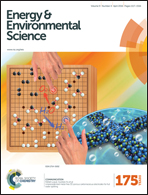The growth of a CH3NH3PbI3 thin film using simplified close space sublimation for efficient and large dimensional perovskite solar cells†
Abstract
A way to fabricate pin-hole-free perovskite thin films with optimal crystalline morphology and full coverage is crucial for highly efficient and large scale perovskite solar cells (PerSCs). Herein, we demonstrate a new approach of simplified close space sublimation (CSS) deposition to grow a high quality CH3NH3PbI3 thin film in a low-vacuum and even non-vacuum oven. In this method, a highly crystallized and uniform perovskite film can be easily obtained by simply controlling the thickness of the PbI2 and CH3NH3I films, the reaction time of CH3NH3I vapor with the PbI2 film, and the distance of the sublimation space. With this approach, a large area of 100 mm2 can be easily obtained. The crystallinity of the perovskite film was investigated using X-ray diffraction (XRD) and the morphology of the perovskite thin film was examined using atomic force microscopy (AFM) and scanning electron microscopy (SEM). The planar heterojunction PerSCs with a structure of FTO/PEDOT:PSS/CH3NH3PbI3/PCBM/Al were fabricated and power conversion efficiencies of 16.2%, 12.9% and 10.8% were achieved for the devices with a photoactive area of 4 mm2, 25 mm2 and 100 mm2, respectively.


 Please wait while we load your content...
Please wait while we load your content...